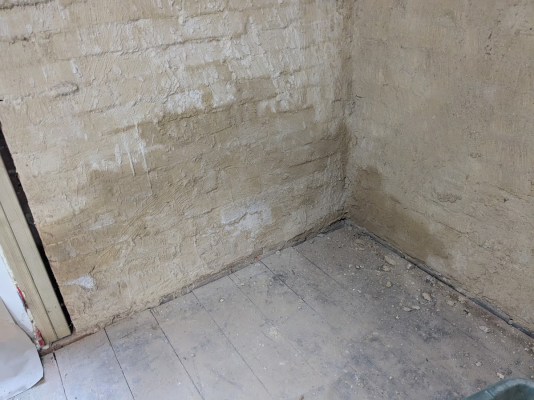Van Bergan
Member
- Messages
- 18
- Location
- Kent
I'm well into an extensive renovation of my Victorian solid brick walled semi detached.
After lots, and lots, and lots! of research I have settled on the IWI arrangement below.
Rationale is the build-up being airtight will not have large volumes of domestic moisture transported into it, and the (reasonably) vapour open materials will allow diffused moisture to freely dry to either/both the inside and outside.
The damp patches do not feel noticeably damp to the touch although they are certainty visible and register ~25% on the damp meter, as opposed to ~12% where dry (I am aware that this damp meters measure salts as a proxy)

Points to note:
There is a reasonable dry cellar below the ground floor, it is damp but certainly not flooded.
External ground level surround the house ranges between a foot and two below internal floor level and is freely draining.
Brickwork external face does not appear to be wet, certainly no obvious correlation with the patches
Underground drainage is in good shape
Roof line is also in good shape.
So the issue is I cannot see any oblivious source of this apparent dampness, could this be a case of the much debated rising damp?
I'm concerned that if I just crack on and install the IWI as is, I may have mould issues down the line.
Appreciate to hear if anyone else has had a similar situation.
I imagine the IWI can handle some moisture but how much?
Would Steico flex wood fibre boards (be a safer option vs Rockwool) in these seemingly damp areas?
TIA
After lots, and lots, and lots! of research I have settled on the IWI arrangement below.
Rationale is the build-up being airtight will not have large volumes of domestic moisture transported into it, and the (reasonably) vapour open materials will allow diffused moisture to freely dry to either/both the inside and outside.
- From external to internal:
- Existing 9 inch solid brick wall with original lime mortar joints (All in reasonable shape, some repointing will be required but not immediate)
- Lime parge coat. I have applied this as my airtight layer
- 100mm timber stud wall located positioned ~5mm to 10mm off external walls
- 70mm Rockwool insulation batts within studwork
- Gypsum plasterboard and skim finish
- Off the shelf vapour open paint (ie not vinyl paint)
The damp patches do not feel noticeably damp to the touch although they are certainty visible and register ~25% on the damp meter, as opposed to ~12% where dry (I am aware that this damp meters measure salts as a proxy)

Points to note:
There is a reasonable dry cellar below the ground floor, it is damp but certainly not flooded.
External ground level surround the house ranges between a foot and two below internal floor level and is freely draining.
Brickwork external face does not appear to be wet, certainly no obvious correlation with the patches
Underground drainage is in good shape
Roof line is also in good shape.
So the issue is I cannot see any oblivious source of this apparent dampness, could this be a case of the much debated rising damp?
I'm concerned that if I just crack on and install the IWI as is, I may have mould issues down the line.
Appreciate to hear if anyone else has had a similar situation.
I imagine the IWI can handle some moisture but how much?
Would Steico flex wood fibre boards (be a safer option vs Rockwool) in these seemingly damp areas?
TIA
